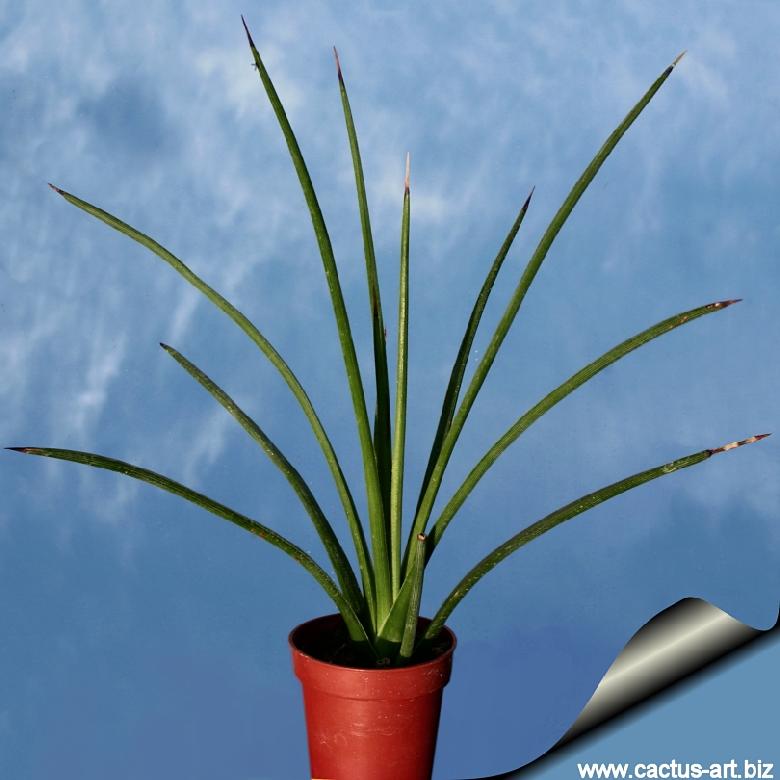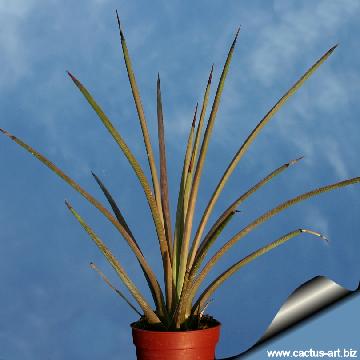Accepted Scientific Name: Agave stricta Salm-Dyck
Bonplandia 7(7): 94 (-95) 1859 Notes = striata

Agave stricta (Needle Leaf Agave)
(A young specimen) It is a mid-sized Agave that forms perfectly spherical rosettes up to 80 cm in diameter, that consist of countless hard, narrow leaves with a pronounced terminal spike.
Origin and Habitat: Agave strictaSN|568]]SN|568]] is native to the Tehuacan Valley of southern Puebla and northern Oaxaca, in Mexico.
Habitat: It is generally found on dry hills and on flats in the open desert.
Ecology: It is one of the few non-monocarpic agaves. The initial rosettes, after the flower stalks finish blooming in mid-summer, branch and continue to grow, eventually creating a stack of porcupine-like balls.
Synonyms:
See all synonyms of Agave stricta
Common Names include:
ENGLISH: Hedgehog Agave, Globe Agave, Needle Leaf Agave, Needle Agave
FINNISH (Suomi): Siiliagaave
RUSSIAN (Русский): Агава прямая
Description: It is a small species, forming large balls of skewer-like leaves and looking like a very nasty porcupine. This species has the tightest spherical shape of any agave and will form offshoots to create a colony of rosettes. Each rosette grows in a slightly different direction and reminds one of a freeze-frame photo of grasses blowing in the wind or of forests of anemones moving with the currents.
Stem: Thick branched.
Rosettes: Individual rosettes, with hundreds of thin leaves, 30 to 100 cm in height and width.
Leaves: Narrow, evergreen, yellow-green, green or glaucous blue, square to roundish in cross-section , toothless on the margin, about 35 cm long; thick at base, then narrowing to end in a very sharp spine. The forma rubra (red form) has thin red longitudinal lines on the leaves that give it a red colour that enhances under stress condition (especially drought, strong sun and cold)
Flowers: The flowers vary from green to reddish brown or purple, on a dense150-200 cm spike-like raceme. It is one of the few non-monocarpic Agaves (just like A striata)
Blooming season: July to september. May flowers when mature at 8-10 years.
Remarks: It is very similar to Agave striata, but tends to have more and somewhat curved leaves, shorter flower tubes and a generally more symmetrical shape. In addition the leaves have a rounder section. A mature plant of Agave sticta looks like a meatball or a balled-up hedgehog. Once you have seen this plant, you won't confuse it with the similar looking and sounding Agave striata.
Subspecies, varieties, forms and cultivars of plants belonging to the Agave striata complex-group
- Agave striata Zucc.: Dense, suckering rosette succulent with unique spiny pencil-like foliage, with nice spherical growth that branch profusely from the base. It very similar to Agave stricta, and can be easily confused with a Yucca.
- Agave striata var. californica (Jacobi) A.Terracc. in A.Terracc.
 Agave striata f. minima: Dwarf plant that only reach a maximum size of 15-25 cm.
Agave striata f. minima: Dwarf plant that only reach a maximum size of 15-25 cm. Agave stricta Salm-Dyck: Forms large individual rosettes, with hundreds of thin leaves, 30 to 100 cm in height and width. This species has the tightest spherical shape of any agave and looks like a very nasty porcupine. .
Agave stricta Salm-Dyck: Forms large individual rosettes, with hundreds of thin leaves, 30 to 100 cm in height and width. This species has the tightest spherical shape of any agave and looks like a very nasty porcupine. . Agave stricta f. nana Minas Asbestos: It is a very small selection that forms a compact spherical rosette, with many stiff, very narrow, glaucous-blue linear leaves. Will form offshoots to create a colony of rosettes.
Agave stricta f. nana Minas Asbestos: It is a very small selection that forms a compact spherical rosette, with many stiff, very narrow, glaucous-blue linear leaves. Will form offshoots to create a colony of rosettes. Agave stricta f. rubra hort.: (a.k.a. Red form) it has thin red longitudinal lines on the leaves. The red colouratin enhances under stress condition (drought, strong sun and cold expecially in winter)
Agave stricta f. rubra hort.: (a.k.a. Red form) it has thin red longitudinal lines on the leaves. The red colouratin enhances under stress condition (drought, strong sun and cold expecially in winter)
 Agave striata subs. stricta (Agave stricta) Photo by: Cactus Art
Agave striata subs. stricta (Agave stricta) Photo by: Cactus ArtSend a photo of this plant.The gallery now contains thousands of pictures, however it is possible to do even more. We are, of course, seeking photos of species not yet shown in the gallery but not only that, we are also looking for better pictures than those already present.
Read More... Cultivation and Propagation: A. stricta is a versatile and very hardy plant that can be grown in half-shade to full-sun. It can take moderate to severe freezes, and is extremely drought tolerant. In winter watering this plant can be done once every 1-2 months, there is no need to mist the leaves. Agave strictaSN|568]]SN|568]] is theoretically hardy to -4° C, particularly when dry - but it is best to avoid severe freezing temperatures. Heat Tolerance: Excellent
Propagation: Relatively easy to propagate by suckers (if available) Remove the basal suckers in spring or summer, and let the cuttings dry for a few days before inserting in compost.












